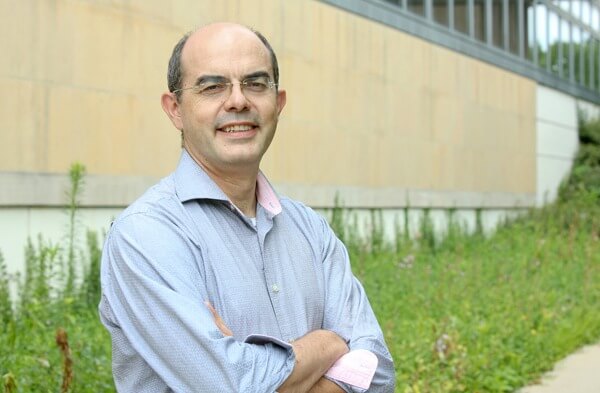Researchers at NIU are investigating ways to boost the power of compact electron accelerators, with potential applications for homeland security and pollution cleanup.
In a new research project funded by the U.S. Department of Energy, faculty in the departments of physics, electrical engineering, mechanical engineering, and under the Northern Illinois Center for Accelerator and Detector Development (NICADD), will develop a high-current electron beam that can be integrated directly into a superconducting radiofrequency accelerator being designed at Fermi National Accelerator Laboratory.

Phillippe Piot
Principal investigator Phillippe Piot, Ph.D., a professor of physics at NIU, said the electrons will be generated by millions of nanoscale pillars.
“These pillars, when subjected to high voltage, act as lightning rods that can sustain electric fields on the order of 1 trillion volts per meter at their extremities,” he said. “These large electric fields can then pull the electron from the pillar, resulting in a high-current electron beam.”
The pillars will be built by Assistant Professor of Electrical Engineering Venumadhav Korampally, Ph.D., using the Microelectronics Research and Development Laboratory at NIU and the Center for Nanoscale Materials at Argonne National Laboratory.
Once the electron beam has been generated, it has to be accelerated in order to have practical application. The researchers hope to create a compact design in which the pillars are mounted directly to a superconducting accelerator. Assistant Professor of Mechanical Engineering Iman Salehinia, Ph.D., is conducting materials and design analysis to make sure the machine and all of its components will fit together properly and be able to stand up to the conditions they are under.
A key part of the analysis is considering the temperature gradient, Salehinia said. When activated, the temperatures within the machine will range anywhere from 450 degrees below zero to 80 degrees above.
“It’s like taking a very cold glass and pouring hot coffee into it,” Salehinia said. “Some materials will expand and some will contract, and we want to make sure that’s in the right balance and won’t cause parts to crack or fail and hurt the performance of the device.”
If successful, Piot said the developed electron sources could be used in compact accelerators to break the chemical bonds of contaminants in polluted water. The electron source could also generate large quantities of X-rays or gamma rays for homeland security applications like scanning cargo or detecting nuclear materials.
